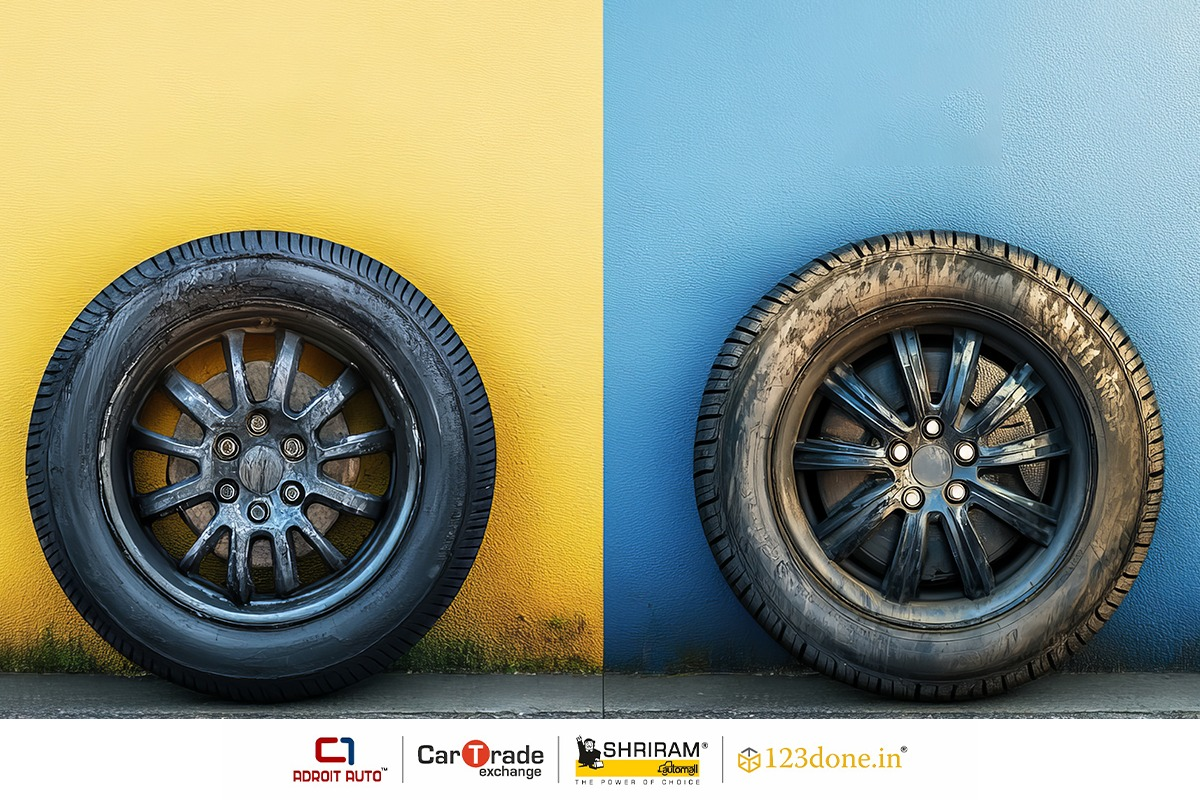When to Change Car Tyres: Signs, Tips & Expert Guide

The one part of the car which ensures its mobility are the tyres. These are the components that connect the car to the road. This makes them more vulnerable to damage die to road conditions, friction, and driving style. Knowing when is the right time to change tyres hence becomes pristine. Ideally, when the tread depth is below the wear indicators, and visible signs like wears, bulges, or cracks are there, change car tyres. The car tyres should also be replaced if they are more than six years old, no matter how fine they appear to you.
This blog will tell you when is the right time to change car tyres and how do you change a car tyre. Keep reading ahead for a full knowledge about tyres.
When is the Right to Change Car Tyres
Car tyres are consumable, and hence they will eventually wear out and would be needing a replacement.

Let us go through the problems that people encounter to know when to change car tyres:
Tyre Tread Worn-out
With regular driving, car treads start losing depth and it becomes easily identifiable. Tread depth indicators help tell the drivers know when a tyre is not safe to be used further. The ideal tread depth for the segment of passenger cars is 1 mm. You know that its time to change the tyre when the markings go below the 1 mm limit.
Balancing of Wheel and Alignment
Wheel alignment of a car has to do with the suspension of your car, i.e. the system that connects your car tyres with the rest of the vehicle. If the car tyres are not aligned properly, they will wear out quickly. The wheel balancing system help distribute weight uniformly to the car tyres. If any issue comes, the car might go out of balance and your car tyres would also be ruined.
Punctures Happening Frequently
If you start getting frequent punctures in your car tyres, it is another clear sign that your tyres need a replacement. Although puncture risk is present in both new and old tyres, but worn-out car tyres are more likely to get a puncture from even the slightest bumps or tiniest objects. So, be sure to buy a new tyre if your old one starts getting frequent punctures.
Age of Car Tyre
All tyres must be replaced after a period of 6 years. This is the life cycle of a tyre, beyond this limit, no car tyres should be used. This is when the chemical compounds of the tyres start to deteriorate past their usable stage. Therefore, do not miss to check the age of your car tyres.
Sidewalls Gets Damaged
If unusual bumps or cracks are showing up on the sidewalls of your car tyres, it becomes very unsafe to drive. Sidewalls are responsible for keeping the tyres upright and also protecting the structure of the tyres. If you will keep driving without a proper sidewall, the tyre can blowout.
Reduced Efficiency of Brakes
When you apply brakes and feel that the efficiency of the brakes has been significantly reduced, there can be two reasons. One can be worn out brake pads or tyre worn out. This suggests that your car tyres are damaged to the extent that the grip needed for braking efficiently is not there anymore. Speeding with these types of tyres is very unsafe and risky.
End of Life
There is a certain kilometre limit for driving around with the tyres. Driving car tyres beyond their rated mileage can be dangerous. Replacing the tyres after they have run their course will also help you ride safer and avoid inconvenient situations such as a flat tyre.
How Do You Change a Car Tyre
If you get stranded with a flat tyre in the middle of nowhere, knowing how to change it can be a lifesaver. Changing a car tyre is a part of general vehicle maintenance which can be really helpful and is a life skill.

Let us take you through the guide on how to change car tyres:
First you need to have some important tools which include a car jack, lug wrench, flashlight, wheel wedges, reflective warning signs, canned air, and safety gloves.
Placing the Tools
When changing a car tyre, look for a flat surface on the road away from the traffic and park your car. Make sure that your hazard lights are on and the tools are placed in order. Take your spare wheel out and look for jack placement markings on your car’s running board, located in the metal strip below the doors. If you are not able to find it, look on the underside as these markings usually appear like small dimples in the metal.
Lifting the Car
Place the jack aligning the contours to match the marking and lift the car. If the jack does not sink into the earth, you are doing it right but do not lift the car entirely just yet. Remove the plastic cover of at the centre of the wheel known as hubcap and then loosed up the lug nuts a bit. This will make removing the lugs easier later on. Now, lift the car up by cranking up the jack.
Changing the Car Tyre
Start removing the lug nuts using the lug wrench and take off the tyre. Line up the spare tyre against the lug bolts and then push inwards. Gently put back the lug bolts and tighten them. Then bring the car down slowly and remove the jack. After all this, fix the hubcap back and let the vehicle rest for a bit.

Conclusion
This expert guide suggests you the signs when to change your car tyres and the tips on how do you change your car tyres. Following this guide will ensure a smooth replacement of worn-out tyres. Remember the signs that your tyre gives you when it needs a change, and efficiently follow the given steps to change your tyre on your own. You can also take the help of experts when not sure about the procedure, but learning this life skill of changing car tyres will surely take you a long way.
Frequently Asked Questions (FAQs)
1. How do I know when it’s time to change my car tyres?
Ideally, when the tread depth is below the wear indicators, and visible signs like wears, bulges, or cracks are there, change car tyres. The car tyres should also be replaced if they are more than six years old, no matter how fine they appear to you.
2. Can I drive safely with old car tyres?
Driving on worn-out tyres is unsafe. They reduce grip, increase the risk of punctures, and can lead to tyre blowouts. It’s best to replace them as soon as signs of wear or damage appear.
3. How often should car tyres be replaced based on age?
Regardless of how they look, tyres should be replaced every six years. Over time, the chemical compounds in tyres degrade, making them unsafe for driving.
4. How do I change a car tyre safely by myself?
To change a tyre, park on a flat surface away from traffic, turn on hazard lights, and use tools like a car jack, lug wrench, and spare tyre. Loosen the lug nuts, lift the car with the jack, remove the old tyre, fit the spare, tighten the lug nuts, lower the car, and replace the hubcap. Always follow safety precautions or seek expert help if unsure.

 Download Our App
Download Our App



